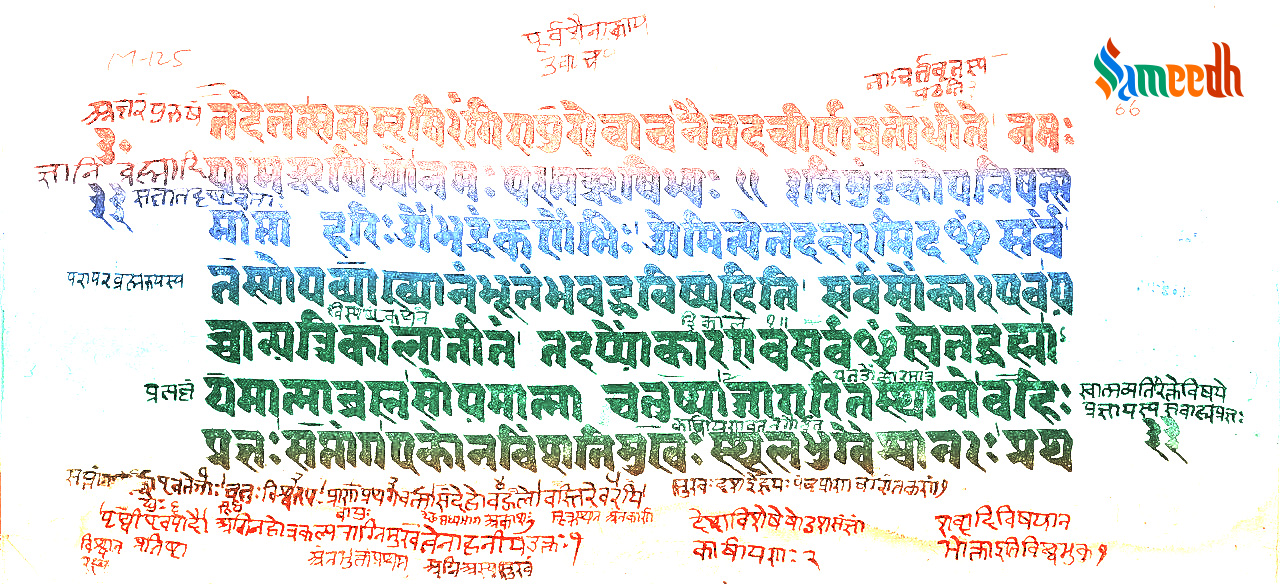The Mandukya Upanishad explains the deep yet common questions about the existence of life and its ultimate resolution through conclusion with the eternal energy, following the AUM principle.

Mandukya Upanisad manuscript page, Verses 1–3, Atharvaveda (Sanskrit, Devanagari script) ; Image Source: Ms Sarah Welch
What is Upanishad?
Upanishad is the scriptures that connect the knowledge given in the four Ved to common people’s lives and traditions. They are called Upanishad (sitting down closely) because Upa means ‘near’ and Shad means ‘to sit’. Many of the Upanishads are written in the style of a conversation between a Guru and a Shishya sitting near the feet of the teacher. Upanishad are aimed at bringing prosperity, enlightenment, and most to the common people’s lives. Every Upanishad is focused on the knowledge covered in one particular Veda from Rigveda, Samaveda, Shukla Yajurveda, Krishna Yajurveda, and Atharvaveda.
The Legacy of Mandukya Upanishad
The authorship of Mandukya Upanishad is usually attributed to Gauḍapaad Acharya – who was a noted scholar of Advait – Vedant Philosophy in the 6th century CE. But the origins of the Upanishad are not known exactly because the knowledge was passed verbally in ancient India, and the creation of scriptures began only later. Gauḍapaad Acharya is considered its author because the entire Mandukya Upanishad is covered in the Mandukya Karika – which is attributed to him. The name ‘Manduka’ means a Vedic school, and ‘Mandukya’ means related to it.
The teachings of Mandukya Upanishad
Mandukya Upanishad is based on the knowledge covered under the Atharvaved. Mandukya Upanishad is the smallest Upanishad as it has only 12 shlok (verses) in it, and it can be easily written on a small piece of paper. However, the knowledge of those crisp and clear shlok pertains to the very existence of life as well as the universe.
Four different states of a life
1: The awake state of a life
The verse 2.1 explains the reality of a life that is awake and connected with the world around it through numerous organs and senses.
2: The dream state of a life
The verse 2.2 explains the nature of a life that is asleep and connected only with the inner world through the intellect and past karma.
3: The deep sleep state of a life
The verse 2.3 explains the condition of a life which has the body and mind both at rest. Then a life becomes a causal body – ‘prajna’.
4: The brahmaroop state of a life
The verse 2.5 explains the connection of a life with the Param Brahma or the eternal energy. Then all the illusions and worldly limitations disappear.
Meaning of AUM
The Mandukya Upanishad explains that the entire universe can be explained using the four-factor principle of A + U + M + Silence. It connects with the four-part symbol of AUM as well as the sound of AUM. “Aum” (also spelled “Om” or “Omkar”) is a sacred sound and spiritual symbol in Hinduism, Buddhism, and Jainism. It is considered to be the most sacred syllable and the most important symbol in Hinduism. The sound of “Aum” is believed to be a powerful vibration that can be used to focus the mind and enter into a meditative state. When it is recited or sung, it is said to produce a positive and calming effect on the mind and body. Many people start and end their meditation and spiritual practices with “Aum”. In Hinduism, “Aum” is believed to be the primordial sound of the universe, representing the beginning, the middle and the end of all things. It is said to embody the three main aspects of the divine: creation, preservation, and destruction.
For example, with regards to time, we can say AUM is Past + Present + Future + Dimension of time. The three sounds of “A” “U” and “M” in “Aum” are believed to symbolize the three stages of cosmic creation. The “A” represents the beginning, or the process of creation. The “U” represents the preservation and maintenance of the universe. The “M” symbolizes the dissolution and destruction of the universe.
It’s also said that “A” represents the waking state, “U” the dream state and “M” the deep sleep state.Also, as explained earlier, with regards to the existence of a life, we can say AUM is Wakefulness + Dream State + Deep Sleep + Brahmaroop.
In the last four verses – from 9 to 12, the Mandukya Upanishad explains the origins of AUM and its true meaning. AUM means a pulse – Adimatva (inception) + Ubhayatva (intermediate state) + Miti (resolution).
In many Hindu traditions, the symbol and sound of “Aum” is associated with the Absolute Reality and Ultimate Truth, also known as Brahman. It is used in meditation, prayers, and other religious practices as a powerful symbol.